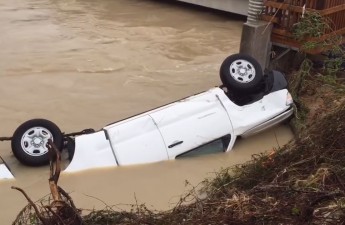
I was glad to be heading back to Columbia after two days of soggy weather at American Rivers’ Board meeting in Beaufort, South Carolina.
I couldn’t stay an extra day to fish the Broad River for redfish with my friend, who also happened to be in the area that weekend for a wedding. I’d be home before dark and escape the worst of what was left of Hurricane Joaquin and the coastal flooding it had caused. Except for a few downpours mixed in with steady rain, the drive back home was uneventful. I was glad to be home, dry and with my family.
I lost count of how many times the National Weather Service flash flood alert on my iPhone went off that night. I do know that each time I was awakened it seemed to be raining even harder, but I wasn’t overly concerned. We were almost a mile from Gills Creek and on high ground, not in an area prone to flooding.
With Sunday morning’s daylight I saw water running across our lightly sloped back yard and ponding at the back of our house. I soon learned that it had overtopped our air vents and spilled into the crawl space flooding it with more than a foot of water and partially submerging our furnace. Not long afterward, our power flickered and went out. Our city-supplied water lost pressure, turned a muddy brown, then stopped altogether. No longer could I think that we were safe from what was a historic deluge. Sixteen inches of rain in 18 hours doesn’t pick favorites.
Or maybe it does. Just blocks away neighbors living closer to Gills Creek were experiencing a major flood that topped the eaves of houses supposedly on high ground.
Even with that much rain, how could Gills Creek carry so much water? It was later that afternoon when I heard of the dam breaks. Cary Lake Dam had failed, then Pine Tree Lake Dam, then Semmes Lake Dam. The destruction continued into Monday with the dam at Upper Rockyford Lake giving way and sweeping along with it the Lower Rockyford Lake Dam. A cascade of dam failures, like dominos in a child’s game, had turned a small tributary stream of the Congaree River into a raging torrent that was unfazed by bridges, buildings and roadways. It indiscriminately carried away those who dared to drive through flooded crossings – many to be rescued by first responders, some not.
We don’t know what the future holds for rivers in the Columbia area. In addition to the Gills Creek dams, dams failed in Lexington County. A total of nine dams were lost and many more are teetering. The historic Columbia Canal, which for generations had supplied Columbia’s drinking water, had a gaping, 60-foot hole blown through its banks, jeopardizing the water supply of almost 200,000 Columbia area customers.
We do know that there is a new normal in Columbia and across South Carolina. Climate change predictions of more frequent and more extreme storms are no longer a theoretical debate for academics. We are living it. No politician, regardless of their persuasion, can ignore what has unfolded in Columbia, right?
This is home to me and my family. We live here. Our hearts go out to our friends and neighbors who lost loved ones to the flooding. When the flood waters recede and the time is right to take stock, my American Rivers colleagues and I will join with Columbia and the state of South Carolina to consider what this new normal means for the management of our local rivers and streams. We look forward to helping communities and the state forge a path forward that ensures healthy rivers and community safety.
